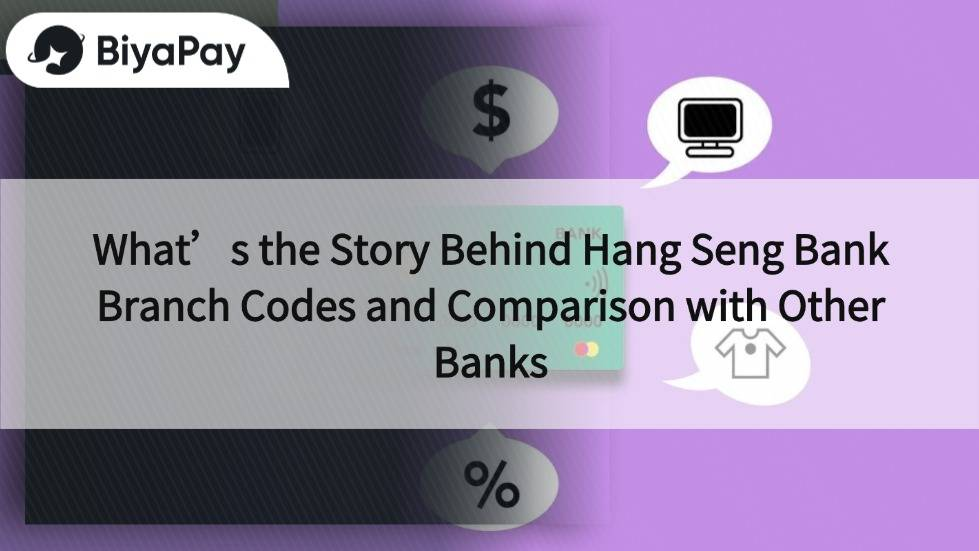- EasyCard
- Trade
- Help
- Announcement
- Academy
- SWIFT Code
- Iban Number
- Referral
- Customer Service
- Blog
- Creator
What’s the Story Behind Hang Seng Bank Branch Codes and Comparison with Other Banks

Image Source: pexels
Many people have noticed when making online bank transfers that they need to enter a branch code. Some wonder, what’s so special about Hang Seng Bank’s branch codes? They want to know if there’s a unique design behind these numbers. When comparing with other Hong Kong banks, people notice that the branch code structures of different banks vary significantly. What are the reasons behind these designs?
Key Points
- Hang Seng Bank branch codes consist of three digits, with each branch having a unique code, facilitating accurate identification and fund transfers.
- Branch codes play a significant role in transfers, clearing, and corporate reconciliation, improving bank operational efficiency and fund security.
- The branch code structures of major Hong Kong banks are similar, but their allocation patterns differ, reflecting each bank’s history and management characteristics.
- The design of branch codes combines historical legacy with modern digital management, ensuring more efficient and secure banking services.
- Customers should carefully verify branch codes during transfers to avoid errors that could lead to funds being sent to the wrong branch.
Hang Seng Bank Branch Codes

Image Source: unsplash
Structure
Hang Seng Bank branch codes consist of three digits, with each branch having its own unique code. When combined with Hang Seng’s bank code, these codes allow precise identification of each branch. For example, when a customer makes an interbank transfer, the system requires both the bank code and branch code to ensure funds reach the designated branch accurately.
According to the financial institution data standards platform, branch codes are 7-character strings, composed of a mix of numbers and uppercase/lowercase letters. This design not only enhances the uniqueness of branch codes but also facilitates digital classification and management between banks. The data standards also support downloads in multiple formats (e.g., XML, JSON, CSV), further strengthening the digital application of branch codes.
Tip: Customers should carefully verify the Hang Seng Bank branch code when filling it out to avoid funds being sent to the wrong branch due to input errors.
Uses
Hang Seng Bank branch codes play a crucial role in daily banking operations. When customers make local or interbank transfers, the system uses the branch code to accurately identify the receiving branch, ensuring funds are safely and correctly deposited into the recipient’s account. Additionally, branch codes are used in the bank’s internal clearing processes, assisting in the automated handling of large volumes of transaction data.
For corporate clients, Hang Seng Bank branch codes help finance departments with account management and reconciliation. Businesses can track fund movements across different branches using branch codes, improving financial transparency.
Moreover, when customers open new accounts or apply for banking services, branch codes are used in forms and system registration, facilitating unified management of customer data by the bank.
- Transfers: Ensure funds are correctly sent to the designated branch.
- Clearing: Improve the efficiency of internal automated processing.
- Reconciliation: Facilitate businesses in tracking fund movements across branches.
- Customer Service: Assist the bank in accurately registering and managing account information.
The design of Hang Seng Bank branch codes combines digital management with practical application needs, making banking operations more efficient and secure.
Other Banks’ Branch Codes
HSBC
HSBC Bank has an extensive branch network in Hong Kong. Each branch is assigned a unique three-digit branch code. When combined with HSBC’s bank code “004,” these codes accurately identify each branch. For example, the head office’s branch code is typically “254,” while other regional branches have different codes. HSBC branch codes are mainly used for transfers, cheque processing, and corporate reconciliation.
Pro Tip: HSBC branch codes can be found on the official website or online banking platform. Customers should verify the correct code during interbank transfers to ensure fund security.
Bank of China
Bank of China (Hong Kong) also uses three-digit branch codes, with the bank code “012.” Each branch is assigned a unique code for easy identification and management. Bank of China branch codes are widely used in local and interbank transfers, cheque cashing, and corporate financial management.
- For example: The head office branch code is “012,” while the Mong Kok branch is “238.”
- Bank of China branch codes can be found on the official website for customer reference.
Standard Chartered
Standard Chartered Bank’s branch codes are also three digits, with the bank code “003.” Each branch has a unique code, such as “004” for the Central branch. Standard Chartered branch codes are primarily used for transfers, clearing, and corporate reconciliation.
| Bank Name | Bank Code | Branch Code Example |
|---|---|---|
| Standard Chartered Bank | 003 | 004 (Central) |
Standard Chartered advises customers to check branch codes before making transfers or opening accounts to reduce errors. The branch code design helps improve the efficiency of internal automated processing, ensuring accurate fund allocation.
Format Comparison

Image Source: pexels
Structural Similarities and Differences
The branch code structures of major Hong Kong banks are generally similar, typically consisting of three digits. This design simplifies transfer and clearing processes. Although Hang Seng, HSBC, Bank of China, and Standard Chartered all use three-digit codes, there are differences in the details.
- Hang Seng Bank branch codes often start with “2,” “3,” or “8,” with some branches assigned different numbers based on region or opening date.
- HSBC Bank branch codes commonly start with “1,” “2,” or “5,” with the head office and major branches having specific codes.
- Bank of China branch codes are more scattered, with no clear pattern, but newer branches tend to use higher numbers.
- Standard Chartered branch codes often start with “0” or “1,” with historically older branches retaining lower numbers.
Note: While the structures are similar, each bank’s branch code allocation method has its own characteristics, reflecting differences in internal management and historical development.
Code Allocation
Branch code allocation is not random but based on each bank’s planning and development strategy. Statistical analysis shows significant differences in branch code allocation among Hong Kong banks. Experts used Spearman’s rank correlation coefficient to analyze the correlation between branch codes of different banks, finding that most banks’ allocation patterns are distinctly different, with p-values typically below 0.05, indicating statistically significant differences.
The following table summarizes the characteristics of branch code allocation for major banks:
| Bank Name | Branch Code Structure | Allocation Pattern | Correlation Analysis Results |
|---|---|---|---|
| Hang Seng Bank | Three digits | Based on region, opening date | Significantly different from other banks |
| HSBC Bank | Three digits | Based on history, region | Significantly different from Hang Seng, Bank of China |
| Bank of China | Three digits | Scattered, newer branches higher | Significantly different from HSBC, Standard Chartered |
| Standard Chartered Bank | Three digits | Based on history, region | Significantly different from other banks |
These data indicate that Hang Seng Bank’s branch code allocation is distinctly different from other banks. Banks develop unique code allocation strategies based on their development history, branch locations, and business needs. This approach enhances internal management efficiency and makes it easier for customers to verify branch information.
Pro Tip: Customers should check the correct branch code during interbank transfers to avoid errors due to different allocation patterns.
Design Reasons
History
The design of Hong Kong bank branch codes originated from the needs of early banking development. As banks expanded their branch networks, they required a simple and clear way to manage branches. Since the 1960s, Hang Seng Bank has used three-digit codes to facilitate internal management and customer identification.
HSBC, Bank of China, and Standard Chartered established similar systems during the same period. These codes reflect the sequence of branch establishment, regional distribution, and business priorities. Banks assign different codes based on the branch’s opening date and location. For example, earlier branches typically receive lower numbers, while newer branches use higher numbers. This approach helps banks track branch history and development.
The historical evolution of bank branch codes reflects the pace of Hong Kong’s financial sector development and highlights banks’ emphasis on management efficiency and transparency.
System
Modern bank branch code designs integrate digital management and international standards. Banks use information technology systems to closely link branch codes with customer data, transaction records, and clearing processes. This improves automated processing efficiency and reduces human errors.
- The Dun & Bradstreet ESG Data Platform demonstrates how banks use diverse data sources to enhance branch management transparency and consistency. The platform covers public and non-public data, adopting globally consistent evaluation standards to facilitate cross-industry comparisons.
- The evaluation methodology combines data from 180 countries, news media, third-party databases, and corporate self-assessments to ensure comprehensive branch code management.
- The ESG Sustainability Index consolidates various corporate data by industry, assisting banks with global and supply chain management.
- The Dun & Bradstreet database has broad coverage and consistent evaluation standards, helping banks unify branch management rules.
- Evaluation metrics reference multiple international standards and continuously adopt new ones to ensure branch management aligns with global practices.
- A practical case from HKB shows that using public data and audit processes can accelerate approval times and improve financial service efficiency.
Through these systems and standards, banks ensure that branch code designs balance historical legacy with modern fintech development, delivering more efficient and secure services to customers and businesses.
Hang Seng Bank’s branch code design is unique, clearly distinguishing each branch. Compared to other Hong Kong banks, Hang Seng’s branch code allocation is more systematic. Understanding these codes can improve daily financial management efficiency. Readers should pay attention to banking details and use branch codes wisely to ensure fund security.
It’s recommended to carefully verify branch codes during transfers to minimize errors.
FAQ
Where can I find Hang Seng Bank branch codes?
Customers can check branch codes on Hang Seng Bank’s official website, online banking platform, or at branches. Bank staff can also provide accurate information immediately.
What happens if I enter the wrong branch code during a transfer?
The bank system may be unable to process the transaction, and funds may be delayed. Customers should verify branch codes to ensure fund security.
What’s the difference between a branch code and a bank code?
A bank code represents the entire bank, e.g., Hang Seng Bank’s code is “024.” A branch code identifies individual branches, and both are required for transfers.
Is there a unified standard for Hong Kong bank branch codes?
Hong Kong banks generally use three-digit branch codes, but allocation methods are determined by each bank. The government platform provides a unified lookup channel.
Do I need a branch code for transfers to Bank of China accounts?
Yes. For interbank transfers to Bank of China (Hong Kong) accounts, the correct branch code and bank code (012) must be entered to ensure accurate fund delivery.
Hang Seng Bank’s branch codes (bank code 024), designed with three digits, ensure accurate transfers and fund security, enhanced by digital management for local banking efficiency, but how can you achieve cost-effective global fund mobility and diversified investments? BiyaPay offers an all-in-one financial platform, enabling seamless trading of US and Hong Kong stocks without offshore accounts, extending Hang Seng’s branch reliability to global markets, including giants like Tencent and Alibaba.
Supporting USD, HKD, and 30+ fiat and digital currencies, real-time exchange rate tracking guarantees cost transparency, while global remittances to 190+ countries feature transfer fees as low as 0.5%, significantly below traditional bank cross-border or interbank transfer costs, with swift delivery to meet global wealth management needs. A 5.48% annualized yield savings product, with no lock-in period, balances market volatility with steady returns. Sign up for BiyaPay today to integrate Hang Seng’s precise branch code services with BiyaPay’s worldwide financial solutions, creating an efficient, secure wealth management experience!
*This article is provided for general information purposes and does not constitute legal, tax or other professional advice from BiyaPay or its subsidiaries and its affiliates, and it is not intended as a substitute for obtaining advice from a financial advisor or any other professional.
We make no representations, warranties or warranties, express or implied, as to the accuracy, completeness or timeliness of the contents of this publication.




Contact Us
Company and Team
BiyaPay Products
Customer Services
is a broker-dealer registered with the U.S. Securities and Exchange Commission (SEC) (No.: 802-127417), member of the Financial Industry Regulatory Authority (FINRA) (CRD: 325027), member of the Securities Investor Protection Corporation (SIPC), and regulated by FINRA and SEC.
registered with the US Financial Crimes Enforcement Network (FinCEN), as a Money Services Business (MSB), registration number: 31000218637349, and regulated by FinCEN.
registered as Financial Service Provider (FSP number: FSP1007221) in New Zealand, and is a member of the Financial Dispute Resolution Scheme, a New Zealand independent dispute resolution service provider.



















